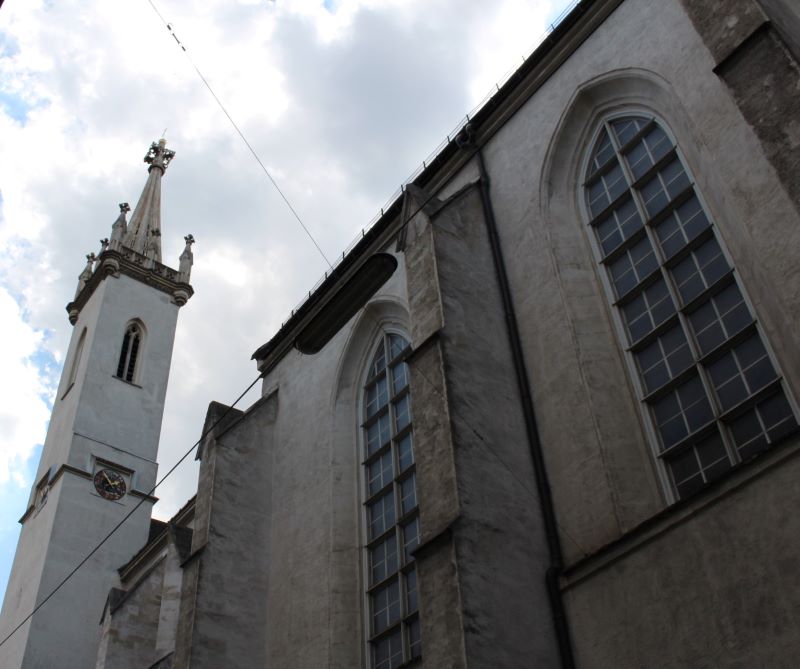Augustinian Church and Augustinian Monastery

1010 Vienna, Augustinerstraße 7 (690.454)
General and Historical Facts
In 1327, King Frederick I (1289–1330) donated an area to the southeast of the old fortress to the Augustinian Hermits to found their monastery there. Three years later, the construction began for the three-aisled hall church (Dietrich Ladtner von Pirn is believed to have been the master builder). It was consecrated in 1349. In 1337, both the erection of the long choir and the construction of St. George’s Chapel, donated by Duke Otto, began.
A cemetery in front of the church was replaced by an imperial garden after having been abandoned in 1460. In 1634, the parish church became an imperial court parish church. It was around this time that the interior design was adapted to the Early Baroque style, including 16 side chapels. The church’s tower was built in 1652, and in (1767–)1769 the façade disappeared behind the left wing of the former imperial court library. Emperor Joseph II (1741–1790) commissioned Johann Ferdinand Hetzendorf von Hohenberg to redesign the church to reflect the Gothic style again; this began in 1783. Also, the number of priests was reduced. The last Augustinian died in 1838. As a consequence of the fighting in the revolutionary year of 1848, a fire broke out in the imperial court library, which spread to the roofs of the monastery and caused the tower to collapse. The latter was re-constructed in 1852. The high altar by Andreas Halbig, which had been initially intended for the Votive Church, was placed there in 1874. The monastery and the church were severely damaged by WW2 bombing.
The parish church underwent renovation until 1950. It has been administered by Augustinians since 1951. The restoration of the interior design between 1996 and 1999 was based on its condition in 1783.
The Augustinian Church is the second largest medieval church in Vienna. In the 17th century, Abraham a Santa Clara preached there. It was also the Habsburg’s wedding church: Leopold I (1640–1705) and Marguerite Teresa of Spain married there in 1666, Maria Theresa (1717–1780) and Francis Stephan of Lorraine (1708–1765) in 1736, Napoleon (represented by Archduke Carl) and Marie Luise in 1810, and eventually Francis Joseph I (1830–1916) and Elisabeth (1837–1898) in 1854. The hearts of 54 Habsburg family members are stored in this parish church (heart crypt).
(Source: Trenkler, Thomas: "Die Hofburg Wien", Vienna, 2004)
The Augustinerstöckl (used by the Austrian National Library, 690.001) was constructed around 1720 as part of the expansion of Basteitrakt (Bastion Wing). The five-story building part separates the monastery courtyard, Klosterhof, from the public park of Burggarten.
Vicarage – Façade refurbishment:
It constitutes the most southern courtyard of the four-storey monastery complex and goes back to the time when the Albertina Palace was expanded. The ground floor was erected around 1720, taking the form of a "sala terrena" – a ground-level section with direct access to the garden of the monastery.
The aim of the restoration and refurbishment works was to carefully clean surviving parts of the original fine render as well as its colour coating and to repair the cracks. The base was treated with a new coat of render made of lime mortar, Swedish cuts (mortar joints) and the division of joints (to prevent secondary stresses due to very rigid construction). Missing parts along the stone surface were complemented and lime sludge was applied to them. After being sanded down, the render received a coat of lime paint, using the Secco technique. The renewed plaster surfaces were painted using lime colour and the Fresco technique after the mortar had set. All wooden surfaces were refurbished by a cabinetmaker and then painted by a painter using oil-based wood stain.
Occupants:
St. Augustin’s Church; Augustinian Order - Austria
Shops: Wiener Souvenir`s, Wäscheflott, theatre ticket desk, Pinocchio
Burghauptmannschaft Österreich – Departments in charge:
Building Management Dep. 301 – Congress Center
HVAC Dep. 306 – HVAC
Property Management Dep. 201 – Administration